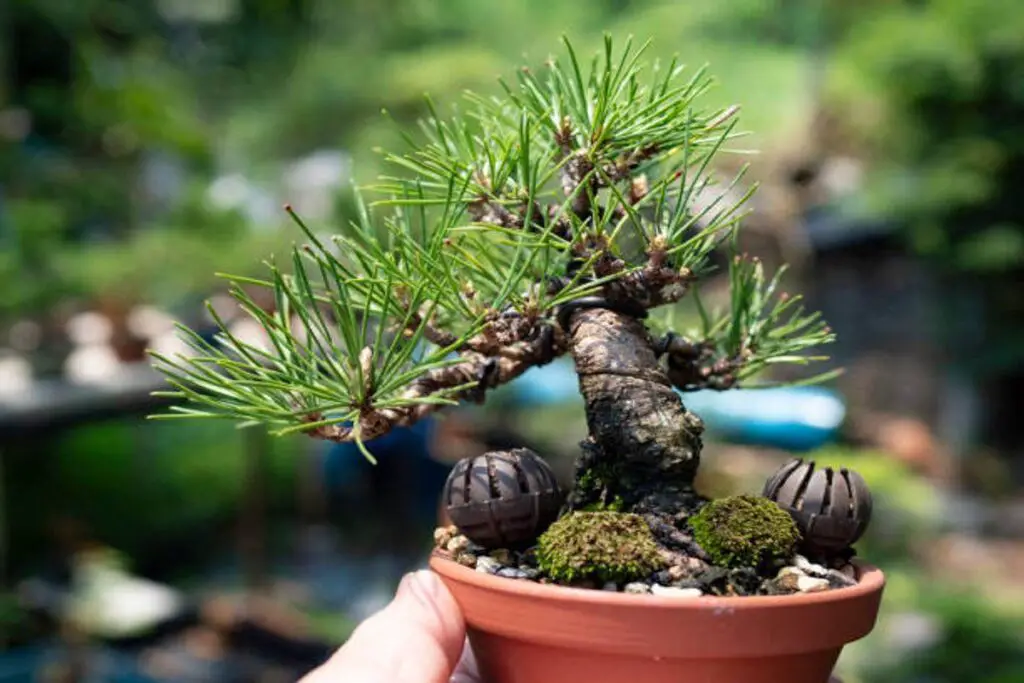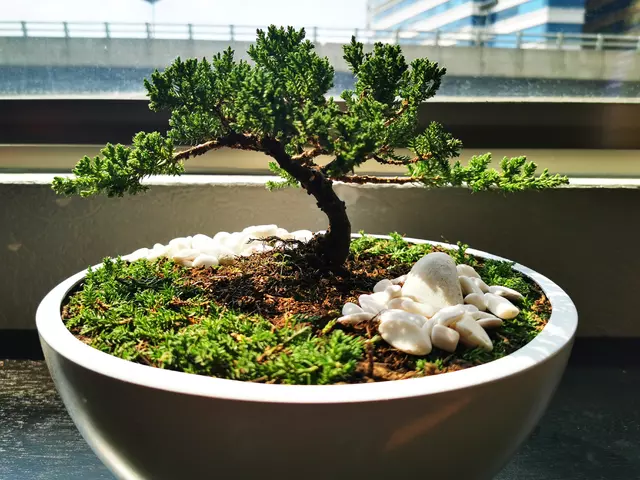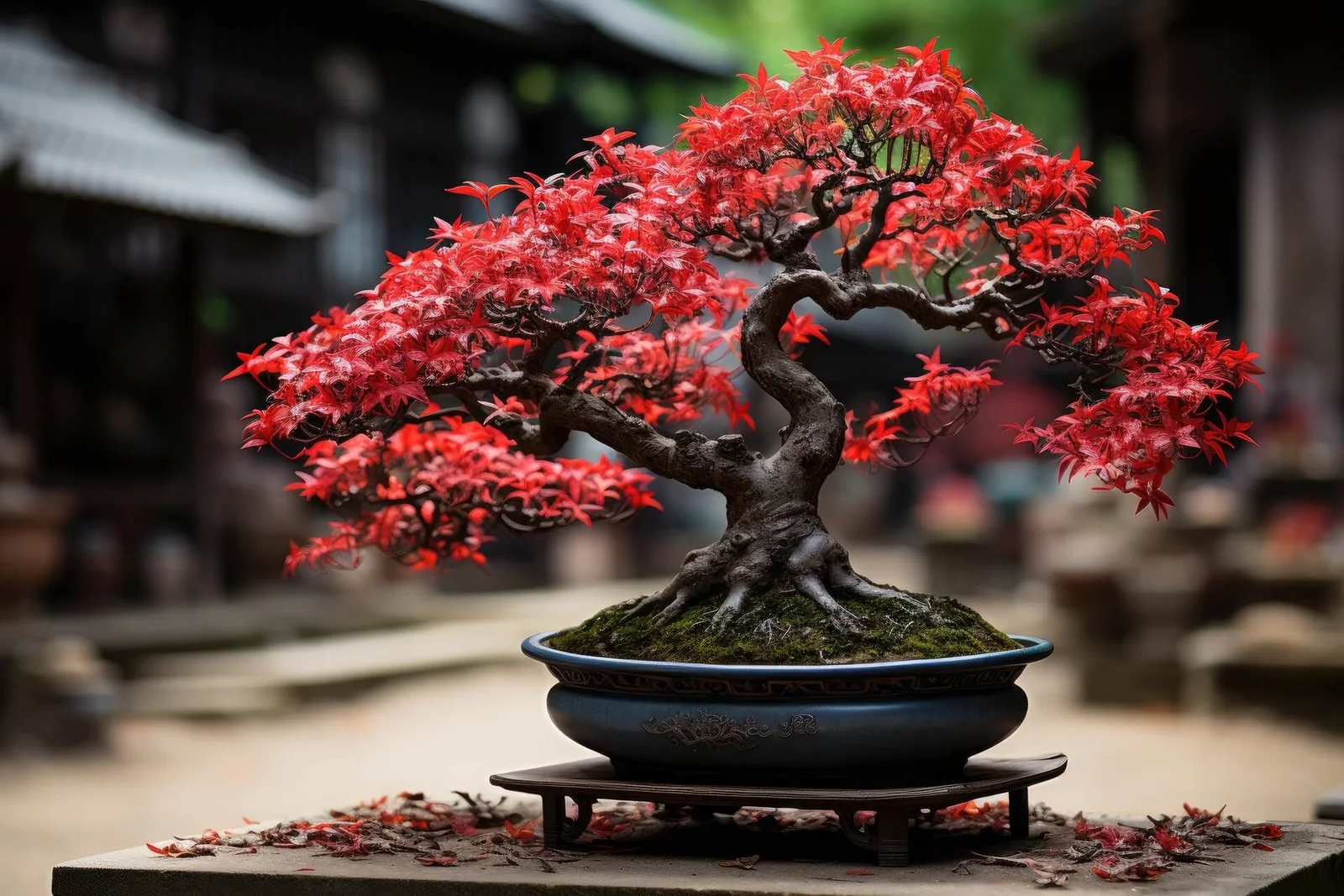Table of Contents
Pine Bonsai, a transformation of pine trees, are popular for cultivating ornamental miniatures in containers. However, they’re not the easiest option for newcomers to the bonsai art form. Bonsai, an ancient Japanese technique of cultivating dwarfed trees in containers, mimics the shapes and sizes of full-sized trees through specialized cultivation methods.
Key Points:
- Pine bonsai can be shaped into almost any bonsai style due to the varied growth patterns, sizes, and colours of pine trees.
- Various species, including Rocky Mountain pines, are suitable for successful bonsai cultivation.
For those up for the challenge, different pine species, including Rocky Mountain pine types, can thrive in bonsai cultivation.
- Common Name: Pine Bonsai
- Botanical Name: Pinus
- Family: Pinaceae
- Plant Type: Tree
- Mature Size: Grows up to 60-80 inches tall
- Sun Exposure: Thrives in full sunlight
- Soil Type: Requires well-drained soil
- Soil pH: Prefers acidic to neutral pH levels
- Native Area: Found naturally in North America, Asia, and Europe

Pine Bonsai Care: Mastering the Art
Pine bonsai trees are often seen as a more advanced choice, not quite beginner-friendly. They’re among the trickiest types to understand, style, and prune, with factors like local climate playing a big role in their needs.
Essential Techniques for Pine Bonsai Success
- Wiring Wonders: To shape your pine bonsai, wiring is key. It involves delicately wrapping wire around branches to gently guide them into the desired positions.
- Know Your Pine: Understanding your pine species is crucial. This helps determine how often it grows (once or twice a year) and when to prune the candles (upright buds at branch tips) during its active growth phase.
- Timing is Everything: Winter months, from late autumn to early spring, are prime time for wiring. This promotes even energy distribution without overwhelming the tree.
Light Requirements
- Sunshine Necessity: Pine bonsai thrive best when basking in full sun for several hours daily.
- Compact Growth: More sunlight results in shorter, denser needles on your pine bonsai.
- Indicator of Need: If your pine bonsai’s needles become leggy and elongated, it’s a clear sign that the tree craves more sunlight.
Soil Requirements for Pine Bonsai Care
- Pine bonsai, like other bonsai types, need a well-draining potting mix.
- Opt for commercially available bonsai soils containing akadama, pumice, organic compost, and fine gravel.
- Pine bonsai thrive in a soil pH range of 5.5 to 6.5.
Keeping Your Bonsai Hydrated
Watering your bonsai is crucial for its health. Pine trees like to stay consistently moist, but they don’t do well if the soil becomes waterlogged. A good rule of thumb is to check the top inch or two of soil—if it’s dry, it’s time to water.
- Keep the soil consistently moist to keep your pine bonsai happy.
- Avoid letting the soil become waterlogged, as pine bonsai can’t tolerate excessive moisture.
- A simple way to gauge watering time is by checking if the top inch or two of soil feels dry.
Temperature and Humidity
- Pine thrive best outdoors year-round due to their hardy nature and frost tolerance.
- When grown in containers, they should be placed in a sheltered spot during winter to shield them from harsh weather conditions.
Moisture Management
- Pine bonsai, like most bonsai varieties, benefit from regular misting, especially in less humid climates.
Fertilization Tips
- Regular Feeding for Growth: Pine bonsai thrive on consistent fertilization for optimal health and appearance.
- Seasonal Feeding: From early spring through late autumn, apply organic bonsai fertilizers to ensure robust growth and vibrant foliage.
- Nitrogen Caution: Avoid fertilizers rich in nitrogen to maintain balanced growth and avoid excessive foliage.
Pine Bonsai Varieties
Types of Pine Ideal for Bonsai
- Pinus thunbergii (Japanese black pine): Known for its unique, twisted trunk and flat-topped appearance, this evergreen pine is a favourite in bonsai circles.
- Pinus mugo (Mountain pine): Its compact growth and dwarf varieties, like ‘Mops’, make it perfect for creating miniature landscapes in bonsai form.
- Pinus sylvestris (Scots pine): With its pyramidal shape and long lifespan, this single-flush pine is a sturdy choice for bonsai enthusiasts.
- Pinus parviflora (Japanese white pine): Featuring a distinctive spreading branch pattern and bluish foliage, this pine adds elegance to any bonsai collection.
- Pinus aristata (Rocky Mountain bristlecone pine): Resilient and slow-growing, this pine thrives in harsh environments, making it a sought-after option for bonsai artists.
Pruning
- Essential Care: Proper pruning is crucial for both the health and beauty of a pine bonsai tree. Start shaping it early to establish a robust branch structure.
- Growth Habits: Pine species typically grow vigorously at the top, which can lead to imbalance if not managed. Improper pruning results in top-heavy growth and sparse lower branches, detracting from the bonsai’s aesthetic appeal.
- Annual Growth: Pines exhibit either one or two annual growth flushes. For species with two flushes, trim elongated spring and summer candles and remove excess old needles from dense areas. Reserve major pruning of main branches for autumn to minimize sap loss.
Propagating Method
- From Cuttings: Bonsai can be propagated from regular trees using cuttings, though it requires patience. Here’s how to do it:
- Take a 2 to 3-inch cutting from a pine tree, angled at 45 degrees, using disinfected pruning shears.
- Plant the cutting 1 inch deep in a pot with bonsai potting soil, keeping it well-watered.
- Place the pot in a sunny spot and wait approximately three weeks for roots to develop.
- Once rooted, the cutting can be pruned and wired into the desired bonsai shape, marking the start of its bonsai journey.
Potting and Repotting Tips
- Repotting isn’t a must-do every year for pine bonsai. Depending on the tree’s age, it usually needs repotting every two to five years. This refreshes the soil and prunes the roots to prevent them from getting cramped. Early spring, just after buds start to swell, is the prime time for this.
- When picking a new pot for your bonsai, consider these points. According to bonsai rules, the pot’s height and width shouldn’t exceed two-thirds of the tree’s size—both for function (root control) and design. Pot colour matters too; ideally, it should match some hues in the tree. The goal is harmony between tree and pot.
- Whether you stick with bonsai tradition or not, you can grow bonsai in various containers. Key is ensuring the pot drains well and matches the tree’s size.
Dealing with Common Pests and Diseases
- Pine bonsai sadly attract pests and diseases. Watch for aphids, spider mites, scale, and caterpillars. Also, root rot (often from too much watering or poor drainage) and fungal diseases are common foes.
Common Issues with Pine Bonsai
Pine bonsai can be a challenge to nurture, mainly due to their growth patterns, which differ significantly from faster-growing varieties like ficus. Here are some common problems to watch out for with your pine bonsai:
- Yellowing Needles: Several reasons could be behind yellowing needles on your pine bonsai. Here’s what to consider:
- Newer needles yellowing at the base may indicate overwatering; let the tree dry out.
- Yellow bands on needles could signal physical damage or fungal disease.
- Yellowed tips might mean the bonsai is getting too much sunlight.
- Poor water quality or drainage issues may also lead to yellowing.
- Consider fertilizer needs or the possibility of insect infestations.
- Leggy Needles Leggy, stretched-out needles on a pine bonsai suggest it needs more sunlight. Improved light conditions can shorten needle length, which is ideal for pine bonsai trees.
- Dying Individual Branches
- Physical damage may cause yellowing in branches, sometimes without an obvious cause.
- Insufficient light can lead to blackening or dying branches.
- Tree boring beetles or flathead borers may also be culprits, wreaking havoc on your pine bonsai.
- Borer damage can jeopardize the tree’s health to a point where saving it might not be feasible.
- Use wound paste after pruning to prevent future infestations.
▶Click Here to download this article as PDF









One response to “How To Care For Pine Bonsai”
[…] Japanese Maple Bonsai may prefer a different mix than a Pine Bonsai. […]